Comparison of 0W-20 Engine Oils
- May 24, 2019
- Autor ATO24 Team (Blogautor)
ATO24 Oil Analysis - 0W-20 Engine Oils with VW 508 00 / 509 00 Approval
The automotive industry is nowadays moving in the direction of more fuel-efficient engines. Consequently, this development also has an impact on engine oils as the development here is clearly leaning towards low viscosity 0W-30 and 0W-20 engine oils, which enable lower fuel consumption compared to “conventional” 5W-30 or 10W-40 engine oils.
The current VW 508 00 / 509 00 approval with the viscosity class 0W-20 and the LongLife IV property is a good example for the current development - and that makes it a very good subject for our latest ATO24 oil analysis.
VW 509 00 / 509 00 Approval
The VW 508 00 approval for petrol engines and VW 509 00 for diesel engines was specifically developed for the latest generation of VW engines. Engine oils with VW 508 00 / 509 00 approval rely exclusively on the viscosity class 0W-20, which significantly reduces wear. The low viscosity in combination with a greatly reduced HTHS viscosity (≥ 2.6 mPas for xW-20) and low friction enable a lower fuel consumption of up to 4 % compared to engine oils with 5W-30 viscosity class.
Due to their bluish colour, engine oils with the VW 508 00 / 509 00 approval are also referred to as "VW Blue Oil". This special colouring is intended to prevent accidental mixing with other engine oils.
However, despite being referred to as VW Blue Oil, the colour is described as being rather green than blue - so in this context please don't be suprised!
0W-20 Oil Analysis - The Testing Procedures
All the engine oils tested here meet the same VW 508 00 / 509 00 approval and also have the same 0W-20 viscosity class - however - are they all really the same or are there still differences between them? What are the potential strengths and weaknesses?
In order to answer these questions and also, among all, achieve a better comparability, we have again, as we already did with our ATO24 0W-30 oil analysis, commissioned a laboratory accredited according to DAkkS in Germany to test and analyse the following points for us:
▶ Viscosity at 40 °C and 100 °C
The Tested 0W-20 Engine Oils
Among the engine oils tested are the original VW G052577 Longlife IV 0W-20, as well as engine oils from renowned manufacturers such as Shell Helix Ultra Professional AV-L 0W-20, Castrol Edge Professional LL-IV FE 0W-20, Mobil 1 ESP x2 0W-20 and Ravenol VSE 0W-20.
Here is an overview of the tested engine oils:
Aral Super Tronic LL IV FE 0W-20:
Approvals: VW 508 00, VW 509 00
Castrol Edge Professional LL-IV FE 0W-20:
Approvals: VW 508 00, VW 509 00, Porsche C20
Fuchs Titan GT1 Longlife IV 0W-20:
Specifications: ACEA C5
Approvals: VW 508 00, VW 509 00, Porsche C20
Liqui Moly Top Tec 6200 0W-20:
Approvals: VW 508 00, VW 509 00
Recommendations: Porsche C20
Mobil 1 ESP x2 0W-20:
Specifications: ACEA A1 / B1 / C5, API SN / SL
Approvals: VW 508 00, VW 509 00, Porsche C20, MB 229.71, Jaguar Land Rover STJLR.51.5122
Motul Specific 508 00 509 00 0W-20:
Specifications: ACEA A1 / B1
Approvals: VW 508 00, VW 509 00, Porsche C20
Shell Helix Ultra Professional AV-L 0W-20:
Specifications: ACEA C5
Approvals: VW 508 00, VW 509 00, Porsche C20
Total Quartz Ineo Long Life 0W-20:
Specifications: ACEA C5
Approvals: VW 508 00, VW 509 00, Porsche C20
VW G052577 Longlife IV 0W-20:
OEM Number: G052577
Approvals: VW 508 00, VW 509 00
Results of the Analysis
The test results are shown in the following bar charts. They do not appear in alphabetical order, but in numerically order. In addition to the following results, we have put them together in a PDF. This can be found under the following link:
In case you are interested in a more precise definition of the individual test procedures, we recommend you have a look at our first oil analysis: ATO24 Oil Analysis: Comparison of 0W-30 Engine Oils
Viscosity at 40 °C and 100 °C

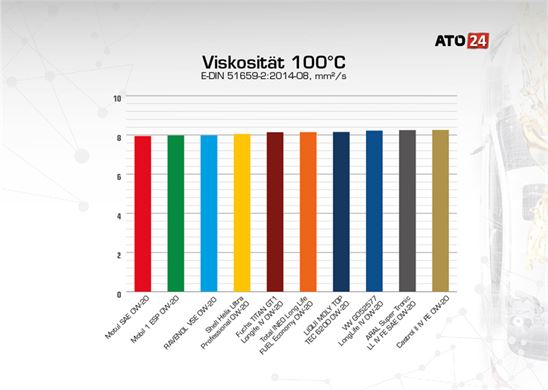
The viscosity grade of an oil increases with decreasing temperatures and decreases with increasing temperatures - as a result, the oil becomes thinner. In order to measure these changes, the viscosity is examined at 40 and 100 °C.
The result is then referred to as kinematic viscosity, which is measured in mm²/s.
The higher the result values, the more constant the viscosity remains at high temperatures - thus enabling constant lubrication despite rising temperatures.
Viscosity Index (VI)
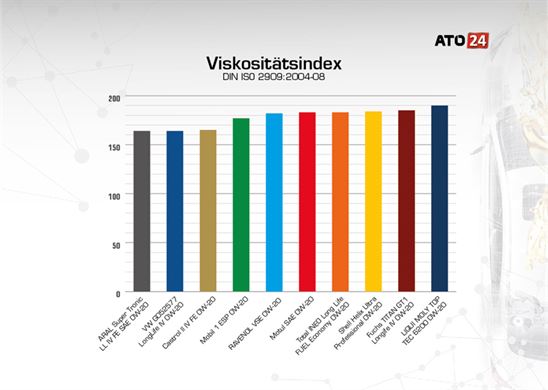
The viscosity index (short: VI) is basically the result of the analysis of the viscosity at 40 °C and 100 °C and is represented in natural numbers.
The higher the viscosity index value of an engine oil, the lower the change in the initial viscosity at high temperatures - making the engine oil more viscosity-stable.
High Temperature High Shear (HTHS)

High Temperature High Shear Viscosity (HTHS) describes the dynamic viscosity at 150 °C under the influence of high shear forces - basically the viscosity at high temperatures and high shear rates (high speed range).
The HTHS value is measured in millipascal seconds (mPas). A higher value indicates a thicker oil film at high temperatures - which means a better protection of the engine against wear, as the oil film remains permanent and guarantees lubrication.
A lower HTHS value, on the other hand, has the advantage that fuel savings and lower emissions can be achieved due to lower internal friction.
Total Base Number (TBN)

The Total Base Number (short: TBN) represents the total number of alkaline reserves in the engine oil and is measured in mgKOH/g.
Alkaline reserves neutralise harmful acids, which are produced by the combustion of sulphurous fuel and lead to corrosion in the engine.
A high TBN value (mgKOH/g) indicates a longer protection of the engine from the negative effect of harmful acids.
Sulphate Ash
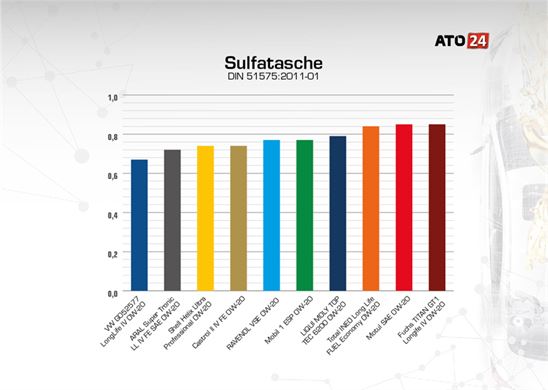
The sulphated ash content is the result of the combustion of engine oil. Metallic abrasion, which is produced during engine operation, is absorbed by the engine oil. Other impurities such as dust can also enter the engine oil.
The laboratory test involves annealing the engine oil and measuring the weight of the sulphated ash (in the form of residual metal oxides and impurities). The sulfate ash is then shown in decimal numbers.
A high content of sulfated ash increases the risk of clogging the fine pores of the diesel particulate filters or the fins of the catalytic converter. A low sulphated ash content is therefore better for the service life of the diesel particulate filter, but reduces the service life of the engine oil due to lower alkaline reserves (see TBN).
Cold Cranking Simulator (CCS)
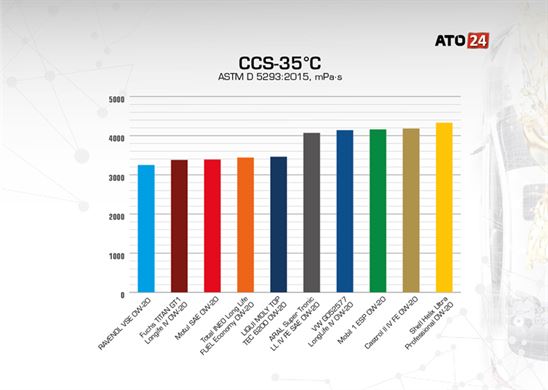
The CCS Cold Cranking Simulator determines the cold viscosity - a characteristic value that indicates the cold viscosity at friction points (cylinder-piston group, wheel bearing, etc.).
This method is used to simulate the dynamic viscosity of the oil during a cold start (the engine is started at low temperatures). The cold viscosity is measured in millipascal seconds (mPas).
In order to correctly evaluate the results from the CCS, it is always necessary to specify the temperatures at which the test was performed. In this oil analysis, a temperature of -35°C was measured.
A lower value implies a lower increase in the degree of viscosity at cold temperatures.
Mini Rotary Viscosity (MRV) -40 °C
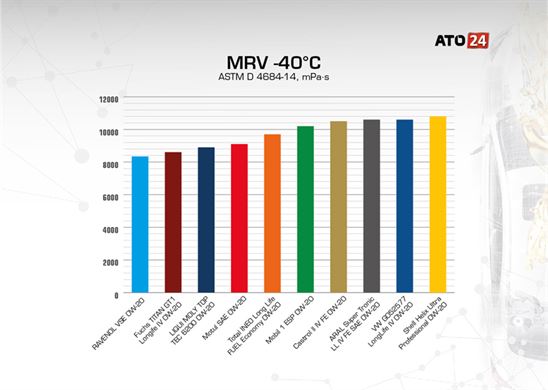
The Mini Rotary Viscometer is a device used to measure the pumpability of an engine oil at low temperatures and a defined temperature profile. The result is measured in millipascal seconds (mPas) and refers in this case to a temperature of -40°C.
A low mPas value indicates a lighter pumpability of the engine oil, which means that it can lubricate the engine faster at low temperatures.
Evaporation loss according to NOACK at 250 °C

The NOACK method investigates the evaporation loss of the engine oil. Engine oils are heated to a temperature of 250°C and exposed to a constant air flow. It is then measured which percentage of the oil evaporates within a time interval of 60 minutes under these conditions.
The higher the percentage, the higher the evaporation of the engine oil in the given time frame.
Pour Point
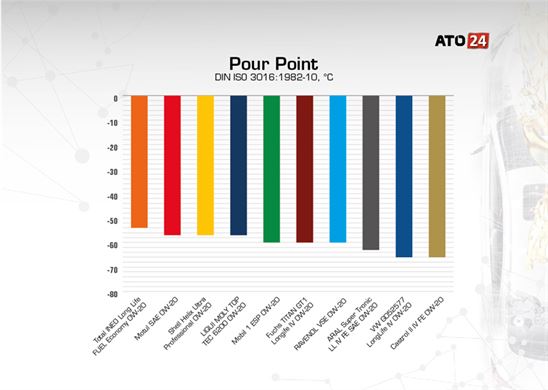
The pour point, measured in -°C, indicates the temperature at which the oil is still flowing.
Viscosity plays an important role for the pour point, because a 10W-40 or a 0W-20 oil must have a prescribed flowability at -25 °C.
A high pour point indicates that a lower temperature is required before the engine oil is no longer able to flow.
Flash Point
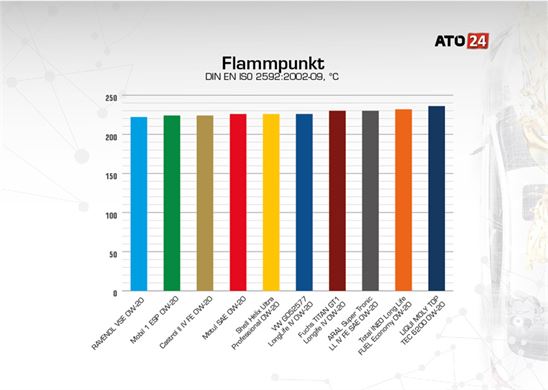
The flash point describes the temperature at which vapours in combination with air would ignite. Among other things, this value is relevant for the transport or storage of the engine oil.
The higher the viscosity, the higher the flash point of the engine oil.
Results of the Oil Analysis
You can find all the results of our analysis in the following chart or as a downloaded by clicking on the button:




